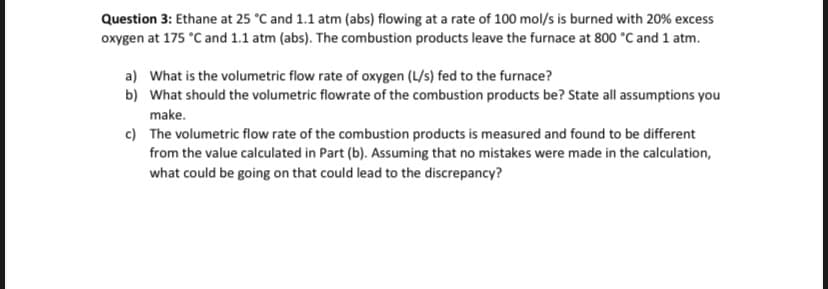Question 3: Ethane at 25 °C and 1.1 atm (abs) flowing at a rate of 100 mol/s is burned with 20% excess oxygen at 175 °C and 1.1 atm (abs). The combustion products leave the furnace at 800 °C and 1 atm. a) What is the volumetric flow rate of oxygen (L/s) fed to the furnace? b) What should the volumetric flowrate of the combustion products be? State all assumptions you make. c) The volumetric flow rate of the combustion products is measured and found to be different from the value calculated in Part (b). Assuming that no mistakes were made in the calculation, what could be going on that could lead to the discrepancy?
Question 3: Ethane at 25 °C and 1.1 atm (abs) flowing at a rate of 100 mol/s is burned with 20% excess oxygen at 175 °C and 1.1 atm (abs). The combustion products leave the furnace at 800 °C and 1 atm. a) What is the volumetric flow rate of oxygen (L/s) fed to the furnace? b) What should the volumetric flowrate of the combustion products be? State all assumptions you make. c) The volumetric flow rate of the combustion products is measured and found to be different from the value calculated in Part (b). Assuming that no mistakes were made in the calculation, what could be going on that could lead to the discrepancy?
Introduction to Chemical Engineering Thermodynamics
8th Edition
ISBN:9781259696527
Author:J.M. Smith Termodinamica en ingenieria quimica, Hendrick C Van Ness, Michael Abbott, Mark Swihart
Publisher:J.M. Smith Termodinamica en ingenieria quimica, Hendrick C Van Ness, Michael Abbott, Mark Swihart
Chapter1: Introduction
Section: Chapter Questions
Problem 1.1P
Related questions
Question

Transcribed Image Text:Question 3: Ethane at 25 °C and 1.1 atm (abs) flowing at a rate of 100 mol/s is burned with 20% excess
oxygen at 175 °C and 1.1 atm (abs). The combustion products leave the furnace at 800 °C and 1 atm.
a) What is the volumetric flow rate of oxygen (L/s) fed to the furnace?
b) What should the volumetric flowrate of the combustion products be? State all assumptions you
make.
c)
The volumetric flow rate of the combustion products is measured and found to be different
from the value calculated in Part (b). Assuming that no mistakes were made in the calculation,
what could be going on that could lead to the discrepancy?
Expert Solution
This question has been solved!
Explore an expertly crafted, step-by-step solution for a thorough understanding of key concepts.
This is a popular solution!
Trending now
This is a popular solution!
Step by step
Solved in 5 steps with 3 images

Recommended textbooks for you

Introduction to Chemical Engineering Thermodynami…
Chemical Engineering
ISBN:
9781259696527
Author:
J.M. Smith Termodinamica en ingenieria quimica, Hendrick C Van Ness, Michael Abbott, Mark Swihart
Publisher:
McGraw-Hill Education

Elementary Principles of Chemical Processes, Bind…
Chemical Engineering
ISBN:
9781118431221
Author:
Richard M. Felder, Ronald W. Rousseau, Lisa G. Bullard
Publisher:
WILEY

Elements of Chemical Reaction Engineering (5th Ed…
Chemical Engineering
ISBN:
9780133887518
Author:
H. Scott Fogler
Publisher:
Prentice Hall

Introduction to Chemical Engineering Thermodynami…
Chemical Engineering
ISBN:
9781259696527
Author:
J.M. Smith Termodinamica en ingenieria quimica, Hendrick C Van Ness, Michael Abbott, Mark Swihart
Publisher:
McGraw-Hill Education

Elementary Principles of Chemical Processes, Bind…
Chemical Engineering
ISBN:
9781118431221
Author:
Richard M. Felder, Ronald W. Rousseau, Lisa G. Bullard
Publisher:
WILEY

Elements of Chemical Reaction Engineering (5th Ed…
Chemical Engineering
ISBN:
9780133887518
Author:
H. Scott Fogler
Publisher:
Prentice Hall


Industrial Plastics: Theory and Applications
Chemical Engineering
ISBN:
9781285061238
Author:
Lokensgard, Erik
Publisher:
Delmar Cengage Learning

Unit Operations of Chemical Engineering
Chemical Engineering
ISBN:
9780072848236
Author:
Warren McCabe, Julian C. Smith, Peter Harriott
Publisher:
McGraw-Hill Companies, The